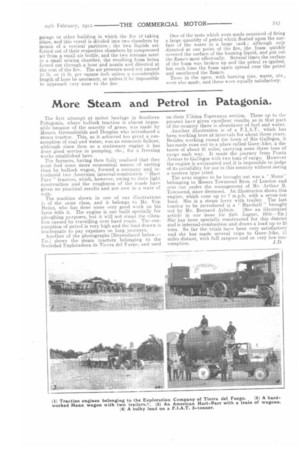Fire Extinction by Gas Bubbles.
Page 6

Page 7

If you've noticed an error in this article please click here to report it so we can fix it.
Interesting Tests of a New Method of Tackling Petrol Fires.
One of our corresPondents recently witnessed some convincing tests with a new and very practical form of fire-fighting plant which should prove extremely valuable for all who have to handle petrol. At the demonstration the representatives of a large London motorbus company were so impressed with it work that they at once placed an order with the maker, and Superintendent Weir, of the Liverpool Fire Brigade— than which brigade probably none has to deal with so many petrol fires per annum—expressed his conviction that the method was the only practicable one which he had witnessed.
The chemicals used, which do not deteriorate, may be stored in open tanks if desired, although it is more convenient to store them in two equal-sized tanks or vessels which may be moved about as one unit. Water is the liquid used, but in each of the vessels a separate and distinct chemical is mixed ; so long as the two liquids remain apart, each is as powerless to put out a petrol fire as is a bucketful of water, but as soon as they mix a relatively-enormous quantity of white. foam is produced, and this, if directed on to any burning material, will quickly cover it with a tenacious blanket of foam, which is capable of preventing the most enterprising petrol flame from remaining long in business. The foam carries and holds innumerable bubbles of carbonic-acid gas ; it is so tenacious that, if thrown upon a ceiling, a glass window, or any other surface, it will hold on for a very long time—many hours in fact. Further, it will gradually spread out over a large area. One of the forms of this kind of apparatus made by the inventors, Messrs. Henry Simonis and Co., of the Pretoria Works, Walthamstow, is shown herewith ; it consists of a 20-gallon tank which is mounted on wheels for convenient transference to any part of a garage or other building in which the fire is' taking place, and this vessel is divided into two chambers by means of a vertical partition ; the two liquids are forced out of their respective chambers by compressed air from a small air bottle, and the two streams meet in a small mixing chamber, the resulting foam being forced out through a hose and nozzle and directed at the seat of the fire. The air pressure need not exceed IO lb. or 15 lb. per square inch unless a considerable length of hose be necessary, or unless it he impossible to approach very near to the fire. One of the tests which were made consisted of firing a large quantity of petrol which floated upon the surface of the water in a large tank; although only directed at one point of the fire, the foam quickly covered the surface of the burning liquid, and put out the flames most effectually. Several times the surface of the foam was broken up and the petrol re-ignited, but. each time the foam again spread over the petrol and smothered the flames.
Tests in the open, with burning tins, waste etc., were also made, and these were equally satisfactory.






















